
Back Depressie (gemoedstoestand) Afrikaans Depression ALS اكتئاب Arabic كتيئاب ARY Depresión AST Çarəsizlik Azerbaijani دپرسلیک (حالت) AZB Depresyon BCL Прыгнечанасць Byelorussian Прыгнечанасьць BE-X-OLD
| Depression | |
|---|---|
 | |
| Lithograph of a person diagnosed with melancholia and strong suicidal tendency in 1892 | |
| Specialty | Psychiatry, psychology |
| Symptoms | Low mood, aversion to activity, loss of interest, loss of feeling pleasure |
| Causes | Brain chemistry, genetics, life events, medical conditions, personality[1] |
| Risk factors | Stigma of mental health disorder[2] |
| Diagnostic method | Patient Health Questionnaire, Beck Depression Inventory |
| Differential diagnosis | Anxiety, bipolar disorder, borderline personality disorder |
| Prevention | Social connections, physical activity |
| Treatment | Psychotherapy, psychopharmacology |
| Part of a series on |
| Emotions |
|---|
  |
Depression is a mental state of low mood and aversion to activity.[3] It affects about 3.5% of the global population, or about 280 million people worldwide, as of 2020.[4] Depression affects a person's thoughts, behavior, feelings, and sense of well-being.[5] The pleasure or joy that a person gets from certain experiences is reduced, and the afflicted person often experiences a loss of motivation or interest in those activities.[6] People with depression may experience sadness, feelings of dejection or hopelessness, difficulty in thinking and concentration, or a significant change in appetite or time spent sleeping; suicidal thoughts can also be experienced.
Depression can have multiple, sometimes overlapping, origins. Depression can be a symptom of some mood disorders, some of which are also commonly called depression, such as major depressive disorder, bipolar disorder and dysthymia.[7] Additionally, depression can be a normal temporary reaction to life events, such as the loss of a loved one. Depression is also a symptom of some physical diseases and a side effect of some drugs and medical treatments.
- ^ "Depression". Cleveland Clinic. 2022. Retrieved 9 June 2022.
- ^ Shrivastava A, Bureau Y, Rewari N, Johnston M (April 2013). "Clinical risk of stigma and discrimination of mental illnesses: Need for objective assessment and quantification". Indian Journal of Psychiatry. 55 (2): 178–82. doi:10.4103/0019-5545.111459. PMC 3696244. PMID 23825855.
- ^ "Depression Basics". NIMH. 2016. Archived from the original on 11 June 2013. Retrieved 22 October 2020.
- ^ "Depression". www.who.int. Archived from the original on 26 December 2020. Retrieved 7 April 2021.
- ^ de Zwart PL, Jeronimus BF, de Jonge P (October 2019). "Empirical evidence for definitions of episode, remission, recovery, relapse and recurrence in depression: a systematic review". Epidemiology and Psychiatric Sciences. 28 (5): 544–562. doi:10.1017/S2045796018000227. PMC 7032752. PMID 29769159.
- ^ Gilbert P (2007). Psychotherapy and counselling for depression (3rd ed.). Los Angeles: Sage. ISBN 978-1-84920-349-4. OCLC 436076587.[page needed]
- ^ American Psychiatric Association (2013). Diagnostic and Statistical Manual of Mental Disorders, Fifth Edition (DSM-5). American Psychiatric Association.[page needed]